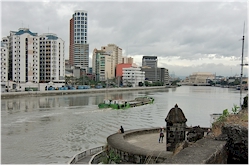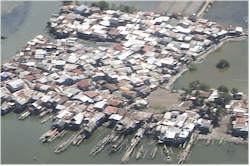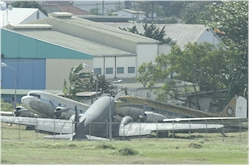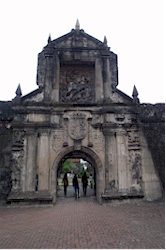
»
Intramuros
»
San Augustin church
»
Fort Santiago
»
Manila cathedral
»
More...

»
Casa Manila
»
San Augustin museum
»
Rizal Shrine
»
National museum
»
More...

»
Rizal park
»
China Town
»
Pasig River
»
Manila Ocean Park
»
Manila shopping malls
»
More...
|
Manila (Metro Manila)
 General.
The city of
Manila used to be called the "Pearl of the Orient". Well,
that was before the historic center was bombed flat during the
Second World war. A part of that historic center has been
rebuilt in the meantime but the city has changed a lot. It
has expanded enormously and swallowed surrounding towns and
villages in the process. Manila city is actually a part of
Metro Manila that comprises of several other towns and cities
such as Makati, Quezon City, Pasay, Pasig,... The
metropolis has become one of largest and most densely populated
areas in the world. Metro Manila is huge, busy and noisy.
Understandably it can feel overwhelming. Some travelers
just want to get out as fast as possible without giving it a
chance. It's a city with lots of problems but also with
its opportunities. So why not stick around for a day or
two (or three)? General.
The city of
Manila used to be called the "Pearl of the Orient". Well,
that was before the historic center was bombed flat during the
Second World war. A part of that historic center has been
rebuilt in the meantime but the city has changed a lot. It
has expanded enormously and swallowed surrounding towns and
villages in the process. Manila city is actually a part of
Metro Manila that comprises of several other towns and cities
such as Makati, Quezon City, Pasay, Pasig,... The
metropolis has become one of largest and most densely populated
areas in the world. Metro Manila is huge, busy and noisy.
Understandably it can feel overwhelming. Some travelers
just want to get out as fast as possible without giving it a
chance. It's a city with lots of problems but also with
its opportunities. So why not stick around for a day or
two (or three)?
 Problems and opportunities.
All mega cities
have problems that are due to their sheer size. Manila is
no different. It wrestles with pollution, overpopulation,
poverty and crime. Ever heard about Smokey Mountain?
That was a huge waste dump where thousands of people lived and
survived by scavenging the garbage and recycling whatever may be
useful. That specific waste dump has been closed now but
unfortunately it is still everyday reality for many people in
Manila living in the slums. As a result of poverty, the
city also has a reputation in the sex industry. For those
who do have a job, salaries are generally low in the Philippines
but no matter how good or bad their situation is, the Philippine
people always stay friendly and keep smiling. The city
also has modern, fashionable areas and some of the biggest
shopping malls in Asia. It's also the center of commerce,
trade, politics and the cultural capital of the country.
In the walled historic center (Intramuros) there are still a few
nice examples of Spanish colonial architecture. Problems and opportunities.
All mega cities
have problems that are due to their sheer size. Manila is
no different. It wrestles with pollution, overpopulation,
poverty and crime. Ever heard about Smokey Mountain?
That was a huge waste dump where thousands of people lived and
survived by scavenging the garbage and recycling whatever may be
useful. That specific waste dump has been closed now but
unfortunately it is still everyday reality for many people in
Manila living in the slums. As a result of poverty, the
city also has a reputation in the sex industry. For those
who do have a job, salaries are generally low in the Philippines
but no matter how good or bad their situation is, the Philippine
people always stay friendly and keep smiling. The city
also has modern, fashionable areas and some of the biggest
shopping malls in Asia. It's also the center of commerce,
trade, politics and the cultural capital of the country.
In the walled historic center (Intramuros) there are still a few
nice examples of Spanish colonial architecture.
 All roads lead to Rome.
Some 2000 years ago this expression was more or less correct
when you were living in the Roman Empire. Nowadays in the
Philippines however, you sometimes get the feeling that all the
roads lead to Manila. Most domestic flights pass through
Manila. Most islands don't have interconnecting flights,
so when you want to go from one island to another, in many cases
you will have to go first to the capital where you must take a
connecting flight. Most of the international flights also
go through Manila and the city has the largest port in the
country... So, whether you like it or not, chances are that you
are going to end up in the city anyway sooner or later. All roads lead to Rome.
Some 2000 years ago this expression was more or less correct
when you were living in the Roman Empire. Nowadays in the
Philippines however, you sometimes get the feeling that all the
roads lead to Manila. Most domestic flights pass through
Manila. Most islands don't have interconnecting flights,
so when you want to go from one island to another, in many cases
you will have to go first to the capital where you must take a
connecting flight. Most of the international flights also
go through Manila and the city has the largest port in the
country... So, whether you like it or not, chances are that you
are going to end up in the city anyway sooner or later.
 History
in short. The area of present-day Manila used to
be a part of the kingdom of Tondo and was already engaged in
trade with surrounding countries and also with China. In
the 16th century, the sultan of Brunei obtained parts of the
Tondo kingdom where he created a satellite state ruled by a
Rajah. A settlement with a basic fortress was established
on the banks of the Pasig river. It was named Maynila.
In 1565 conquistador Lopez de Legazpi arrived in the Philippines.
In 1570, the Spanish captured Maynila and built a new walled
town (Intramuros) with a fortress on the ruins of the old
settlement. Legazpi immediately made Manila the capital
city of the colony. The town benefited from the lucrative
"Manila Galleon trade" between the Spanish colonies in America,
China and other Asian countries dealing in precious metals,
spices, gems, silk and other goods. Between 1762 and 1764,
the town was temporarily occupied by the British, after which
the Spanish regained control. The war between the United
States and Spain also had its consequences in the Philippines
that were taken over by the USA in 1898. The Americans
made changes to the urban planning of the city and introduced
English as an official language. Between 1942 en 1945,
Manila was occupied by the Japanese. The city was
completely devastated due to bombings. The historic center
was virtually completely levelled but partially rebuilt after
the war. In 1946, the country became independent from the
USA. Between 1948 and 1976, Quezon City was the capital of
the country, the only period Manila was not the capital. History
in short. The area of present-day Manila used to
be a part of the kingdom of Tondo and was already engaged in
trade with surrounding countries and also with China. In
the 16th century, the sultan of Brunei obtained parts of the
Tondo kingdom where he created a satellite state ruled by a
Rajah. A settlement with a basic fortress was established
on the banks of the Pasig river. It was named Maynila.
In 1565 conquistador Lopez de Legazpi arrived in the Philippines.
In 1570, the Spanish captured Maynila and built a new walled
town (Intramuros) with a fortress on the ruins of the old
settlement. Legazpi immediately made Manila the capital
city of the colony. The town benefited from the lucrative
"Manila Galleon trade" between the Spanish colonies in America,
China and other Asian countries dealing in precious metals,
spices, gems, silk and other goods. Between 1762 and 1764,
the town was temporarily occupied by the British, after which
the Spanish regained control. The war between the United
States and Spain also had its consequences in the Philippines
that were taken over by the USA in 1898. The Americans
made changes to the urban planning of the city and introduced
English as an official language. Between 1942 en 1945,
Manila was occupied by the Japanese. The city was
completely devastated due to bombings. The historic center
was virtually completely levelled but partially rebuilt after
the war. In 1946, the country became independent from the
USA. Between 1948 and 1976, Quezon City was the capital of
the country, the only period Manila was not the capital.
Picture 1: view on the city from Fort Santiago
Picture 2: Manila slums seen from the air
Picture 3: old airplanes on Ninoy Aquino Airport
Picture 4: entry gate of Fort Santiago
|

»
How to
reach Manila
»
Transport, tours, links,..

|
 General.
The city of
Manila used to be called the "Pearl of the Orient". Well,
that was before the historic center was bombed flat during the
Second World war. A part of that historic center has been
rebuilt in the meantime but the city has changed a lot. It
has expanded enormously and swallowed surrounding towns and
villages in the process. Manila city is actually a part of
Metro Manila that comprises of several other towns and cities
such as Makati, Quezon City, Pasay, Pasig,... The
metropolis has become one of largest and most densely populated
areas in the world. Metro Manila is huge, busy and noisy.
Understandably it can feel overwhelming. Some travelers
just want to get out as fast as possible without giving it a
chance. It's a city with lots of problems but also with
its opportunities. So why not stick around for a day or
two (or three)?
General.
The city of
Manila used to be called the "Pearl of the Orient". Well,
that was before the historic center was bombed flat during the
Second World war. A part of that historic center has been
rebuilt in the meantime but the city has changed a lot. It
has expanded enormously and swallowed surrounding towns and
villages in the process. Manila city is actually a part of
Metro Manila that comprises of several other towns and cities
such as Makati, Quezon City, Pasay, Pasig,... The
metropolis has become one of largest and most densely populated
areas in the world. Metro Manila is huge, busy and noisy.
Understandably it can feel overwhelming. Some travelers
just want to get out as fast as possible without giving it a
chance. It's a city with lots of problems but also with
its opportunities. So why not stick around for a day or
two (or three)? Problems and opportunities.
All mega cities
have problems that are due to their sheer size. Manila is
no different. It wrestles with pollution, overpopulation,
poverty and crime. Ever heard about Smokey Mountain?
That was a huge waste dump where thousands of people lived and
survived by scavenging the garbage and recycling whatever may be
useful. That specific waste dump has been closed now but
unfortunately it is still everyday reality for many people in
Manila living in the slums. As a result of poverty, the
city also has a reputation in the sex industry. For those
who do have a job, salaries are generally low in the Philippines
but no matter how good or bad their situation is, the Philippine
people always stay friendly and keep smiling. The city
also has modern, fashionable areas and some of the biggest
shopping malls in Asia. It's also the center of commerce,
trade, politics and the cultural capital of the country.
In the walled historic center (Intramuros) there are still a few
nice examples of Spanish colonial architecture.
Problems and opportunities.
All mega cities
have problems that are due to their sheer size. Manila is
no different. It wrestles with pollution, overpopulation,
poverty and crime. Ever heard about Smokey Mountain?
That was a huge waste dump where thousands of people lived and
survived by scavenging the garbage and recycling whatever may be
useful. That specific waste dump has been closed now but
unfortunately it is still everyday reality for many people in
Manila living in the slums. As a result of poverty, the
city also has a reputation in the sex industry. For those
who do have a job, salaries are generally low in the Philippines
but no matter how good or bad their situation is, the Philippine
people always stay friendly and keep smiling. The city
also has modern, fashionable areas and some of the biggest
shopping malls in Asia. It's also the center of commerce,
trade, politics and the cultural capital of the country.
In the walled historic center (Intramuros) there are still a few
nice examples of Spanish colonial architecture. All roads lead to Rome.
Some 2000 years ago this expression was more or less correct
when you were living in the Roman Empire. Nowadays in the
Philippines however, you sometimes get the feeling that all the
roads lead to Manila. Most domestic flights pass through
Manila. Most islands don't have interconnecting flights,
so when you want to go from one island to another, in many cases
you will have to go first to the capital where you must take a
connecting flight. Most of the international flights also
go through Manila and the city has the largest port in the
country... So, whether you like it or not, chances are that you
are going to end up in the city anyway sooner or later.
All roads lead to Rome.
Some 2000 years ago this expression was more or less correct
when you were living in the Roman Empire. Nowadays in the
Philippines however, you sometimes get the feeling that all the
roads lead to Manila. Most domestic flights pass through
Manila. Most islands don't have interconnecting flights,
so when you want to go from one island to another, in many cases
you will have to go first to the capital where you must take a
connecting flight. Most of the international flights also
go through Manila and the city has the largest port in the
country... So, whether you like it or not, chances are that you
are going to end up in the city anyway sooner or later.
 History
in short. The area of present-day Manila used to
be a part of the kingdom of Tondo and was already engaged in
trade with surrounding countries and also with China. In
the 16th century, the sultan of Brunei obtained parts of the
Tondo kingdom where he created a satellite state ruled by a
Rajah. A settlement with a basic fortress was established
on the banks of the Pasig river. It was named Maynila.
In 1565 conquistador Lopez de Legazpi arrived in the Philippines.
In 1570, the Spanish captured Maynila and built a new walled
town (Intramuros) with a fortress on the ruins of the old
settlement. Legazpi immediately made Manila the capital
city of the colony. The town benefited from the lucrative
"Manila Galleon trade" between the Spanish colonies in America,
China and other Asian countries dealing in precious metals,
spices, gems, silk and other goods. Between 1762 and 1764,
the town was temporarily occupied by the British, after which
the Spanish regained control. The war between the United
States and Spain also had its consequences in the Philippines
that were taken over by the USA in 1898. The Americans
made changes to the urban planning of the city and introduced
English as an official language. Between 1942 en 1945,
Manila was occupied by the Japanese. The city was
completely devastated due to bombings. The historic center
was virtually completely levelled but partially rebuilt after
the war. In 1946, the country became independent from the
USA. Between 1948 and 1976, Quezon City was the capital of
the country, the only period Manila was not the capital.
History
in short. The area of present-day Manila used to
be a part of the kingdom of Tondo and was already engaged in
trade with surrounding countries and also with China. In
the 16th century, the sultan of Brunei obtained parts of the
Tondo kingdom where he created a satellite state ruled by a
Rajah. A settlement with a basic fortress was established
on the banks of the Pasig river. It was named Maynila.
In 1565 conquistador Lopez de Legazpi arrived in the Philippines.
In 1570, the Spanish captured Maynila and built a new walled
town (Intramuros) with a fortress on the ruins of the old
settlement. Legazpi immediately made Manila the capital
city of the colony. The town benefited from the lucrative
"Manila Galleon trade" between the Spanish colonies in America,
China and other Asian countries dealing in precious metals,
spices, gems, silk and other goods. Between 1762 and 1764,
the town was temporarily occupied by the British, after which
the Spanish regained control. The war between the United
States and Spain also had its consequences in the Philippines
that were taken over by the USA in 1898. The Americans
made changes to the urban planning of the city and introduced
English as an official language. Between 1942 en 1945,
Manila was occupied by the Japanese. The city was
completely devastated due to bombings. The historic center
was virtually completely levelled but partially rebuilt after
the war. In 1946, the country became independent from the
USA. Between 1948 and 1976, Quezon City was the capital of
the country, the only period Manila was not the capital.